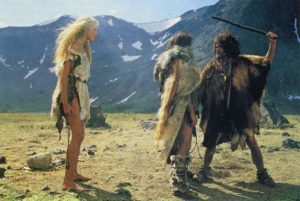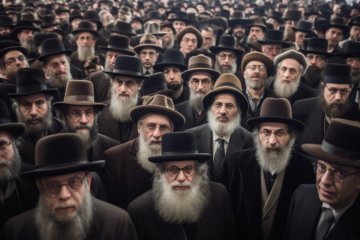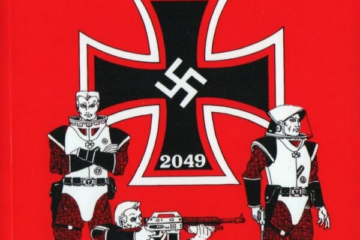Jean Auel’s First Novel Worth Revisiting
 Classic story of the dawn of true humanity — as a race apart — can inspire Whites
Classic story of the dawn of true humanity — as a race apart — can inspire Whites
THE CLAN OF THE CAVE BEAR is a profoundly “racist” novel. How, then, could Jean Auel’s book have spent five months on the New York Times bestseller list? That it is, as popular novels go, very good, is hardly sufficient explanation. What is more to the point is that to appreciate the basic message of the book, the reader must bring something to the reading of it. That something is an understanding of sociobiology. The Clan of the Cave Bear is the first sociobiological novel. (ILLUSTRATION: Scene from the film version of the novel; while good, there was insufficient racial divergence shown.)
Set in the late Pleistocene, the plot concerns an orphaned Cro-Magnon girl adopted into a Neanderthal band, the clan of the book’s title. The girl, Ayla, is “tall, blonde, slender and smarter than the rest.” The Neanderthal’s are “chinless, bearded, bow-legged and barrel-chested.” It is the deeply rooted and fundamental differences between the two human types which furnish the novel’s dramatic tension. Ayla always remains an alien because
she was not Clan. She had not had subservience bred into her for untold generations. She was one of the Others; a newer, younger breed, more vital, more dynamic, not controlled by hidebound traditions from a brain that was nearly all memory. Her brain followed different paths, her full, high forehead that housed forward-thinking frontal lobes gave her an understanding from a different view. She could accept the new, shape it to her will, forge it into ideas undreamed of by the clan — and, in Nature’s way, her kind was destined to supplant the ancient, dying race.
Her antagonist, Broud, son of the clan’s leader
sensed the opposing destinies of the two. Ayla was more than a threat to his masculinity, she was a threat to his existence. His hatred of her was the hatred of the old for the new, of the traditional for the innovative, of the dying for the living. Broud’s race was too static, too unchanging. They had reached the peak of their development; there was no more room to grow. Ayla was part of Nature’s new experiment, and though she tried to model herself after the women of the clan, it was only an overlay, a facade only culture-deep, assumed for the sake of survival.
As the foregoing passages suggest, the novel is overlaid with a veneer of feminism. The position of women in the hunter-gatherer band is stifling to the adventurous blonde girl. But Auel’s feminism is a strange sort, deeply informed by sociobiology. Of the Neanderthals she writes:
The women relied on their men to lead, to assume responsibility, to make important decisions. The clan had changed so little in nearly a hundred thousand years, they were now incapable of change, and ways that had once been adaptations for convenience had become genetically set.
Auel describes the dynamic relationship between biology and culture:
Memories in clan people were sex differentiated. Women had no more need of hunting lore than men had of more than rudimentary knowledge of plants. The difference in the brains of men and women were imposed by nature, and only cemented by culture.
The most powerful passage in the book concerns the attempt of Creb, the clan’s magician/priest, to teach Ayla the rudiments of mathematics. What years of difficult inquiry and reflection have allowed Creb to grasp, the little girl perceives in one instant. The astonished old man then realizes the gulf which separates him and his kind from the blue-eyed Others of the north.
This is a novel for us. In it we see the early days of our people and our first clashes with envious, hate-filled strangers. The lessons are worth learning because the struggle is still on.
(Based on an article in Instauration)
Read more at Jamie Kelso’s online Instauration archive






I read Auel’s books several years ago and enjoyed them to an extent because i find that period of prehistory of great interest. However, the author still manages to impose her politically correct ideals on the situation. In the book ‘The Mammoth Hunters’ she even manages to include a negroid character to the Cro Magnon clan, something that would certainly never have occurred in reality. There is some debate as to what the Neanderthals were actually like and how they became extinct. Auel’s belief is that the two hominid types were tolerant of each other and interacted peacefully. However, an Australian author, Danny Vendramini, has written an interesting book titled, ‘Them and Us’. In it he argues that the two types were radically different in appearance and behaviour, that they… Read more »
I don´t like this story. It´s a creation from a liberal mind and i don´t like it at all.
You’re correct. Auel is a liberal feminist and probably wouldn’t have had her work published if she had introduced a theme that was satisfying to us. So, there is very little choice in modern fiction for white racialists and you have to pick and choose what you can find. I have read politically correct books by authors and interpreted them in a way that was satisfying for me. I have admired characters that the author had intended for me to hate. There are very few novels like the Turner Diaries or Covington’s fiction out there which are overtly racialist and anti jew. It’s a situation that is unlikely to change any time soon.